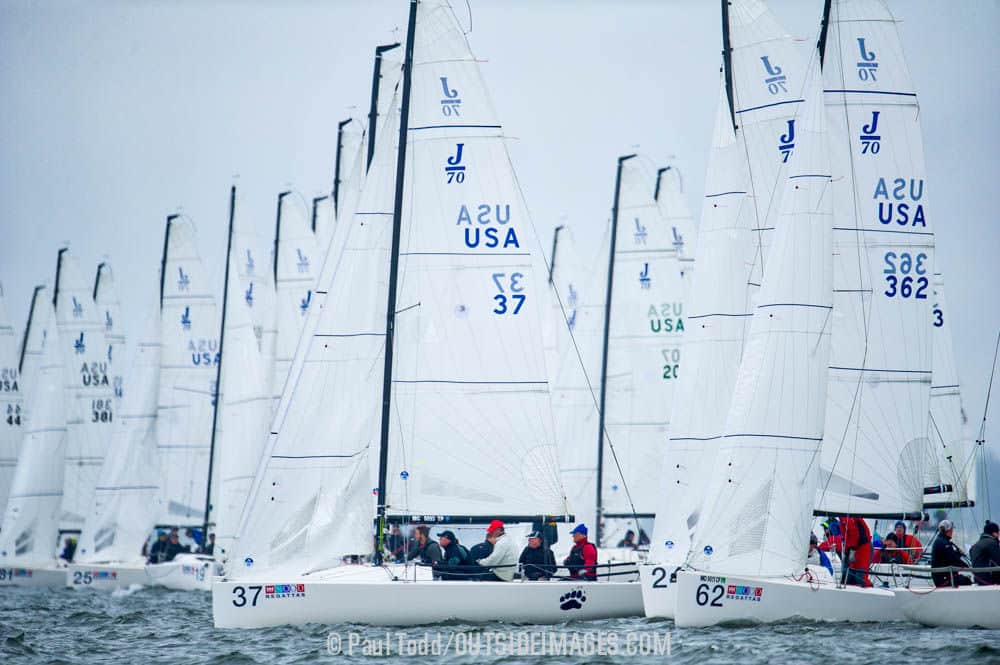
No.1 Most boats perform best upwind with a nearly neutral weather helm. At times, the boat will develop weather helm, especially when in point mode, but an excessive tug on the tiller indicates that the boat is badly out of balance. The quick fixes: sail the boat flatter, raise the centerboard, decrease mast rake or flatten the mainsail.
No. 2 In most conditions, trim the mainsheet so that the top batten is parallel to the boom, rather than pointing inboard or outboard. To judge this, cover the last 10 inches of the upper batten pocket with black tape. Then sight up the leech from under the boom, trim to the right spot and mark the mainsheet.
That said, there are times you can break this rule. When trying to accelerate, develop power in light-to-medium winds or when greatly overpowered in a breeze, the upper batten can be angled outboard 10 to 20 degrees.
Conversely, when trying to point extra high in moderate air, it’s OK to slightly overtrim the main so that the batten hooks to windward in relation to the boom.
No. 3 Figure out what is maximum mast bend, and then strive to attain it in most conditions. Maximum bend is the point at which overbend wrinkles (speed wrinkles, inversion wrinkles, etc.) develop in the lower quarter to lower third of the mainsail. Depending on the boat, you can bend the mast with mainsheet tension, vang tension, backstay tension, rig tension, mast blocks, spreader angle or a combination of all of the above.
No. 4 Every boat has its optimal rig tension. Find out what it is and maintain it. Most boats sail best with the rig just tight enough so that the leeward shroud starts to go slack when it’s blowing 10 to 12 knots.
If the rig is too loose, the jib entry will become quite full. The result is poor pointing ability. Too tight a rig, on the other hand, is sometimes indicated by overbend/inversion wrinkles in the entry of the jib – a small scale version of what happens to a mainsail with maximum mast bend. In addition, if the rig is too tight, the entry of the jib will be quite flat and the telltales will break on both sides of the jib at nearly the same time. In short, the jib becomes hard to steer to.
No. 5 Sail the boat on its lines. Usually, a boat will not perform when its bow or stern is buried in the water. Besides the obvious drag, this can affect the balance of the boat and the tug on the tiller (e.g. bow down creates weather helm). Instead, position the crew weight so the transom is just kissing the water. The result is a smooth, undisturbed wake. Watch where the top sailors sit and copy them.
No. 6 Trim your jib so that, if there were a batten in the middle of the leech, it would be parallel with the centerline of the boat. Put a piece of dark tape on this real or imaginary batten. Only in rare exceptions does a jib ever get trimmed off this position. One time would be for acceleration – ease the sheet so the mid-leech stripe is angled 10 degrees outboard from centerline. This trim is for “first gear” and should match to the mainsheet ease when the main’s top batten is also angled outboard for acceleration.
No. 7 Set your jib leads so that your jib luff breaks evenly from top to bottom. When the boat is overpowered, move the lead aft until the top breaks just ahead of the lower and middle telltales.
No. 8 Set your jib and main luff tension so that there are always some slight horizontal wrinkles along the luff. In very light winds, completely relax the luff tension so there are slight wrinkles all the way from head to tack. Tighten it gradually as the wind builds, so that in heavy air slight wrinkles appear only in the lower few feet of both sails.
If the luff tension is too soft, these wrinkles will be too big. But they’ll never be as long or pronounced as the inversion wrinkles from excessive mast bend or too tight a forestay. Those wrinkles angle from luff to clew. The wrinkles controlled by luff tension are much smaller and lie perpendicular to the luff.
No. 9 Every boat has a “sweet spot” – a precise steering angle for optimum performance upwind. Every boat also has a groove, which is the range of acceptable steering angles. It’s up to the skipper to learn both. The lower end of this range is for acceleration. At this angle, both jib telltales should be streaming straight aft. The luff of the jib should rarely break, but the leeward telltales should never stall.
The center of the groove is the sweet spot, where the boat should be sailed 75 percent of the time. Here you should steer so the weather telltale is slightly stalled. The other end of the groove is the pinching mode, which is used in breezy conditions, especially in flat water. This side of the groove is usually higher than simply letting the weather telltale lift. On most boats you can actually steer so the front of the jib breaks as much as a foot back from the headstay for short periods.
No. 10 When in doubt, check out what the fast guys are doing!









